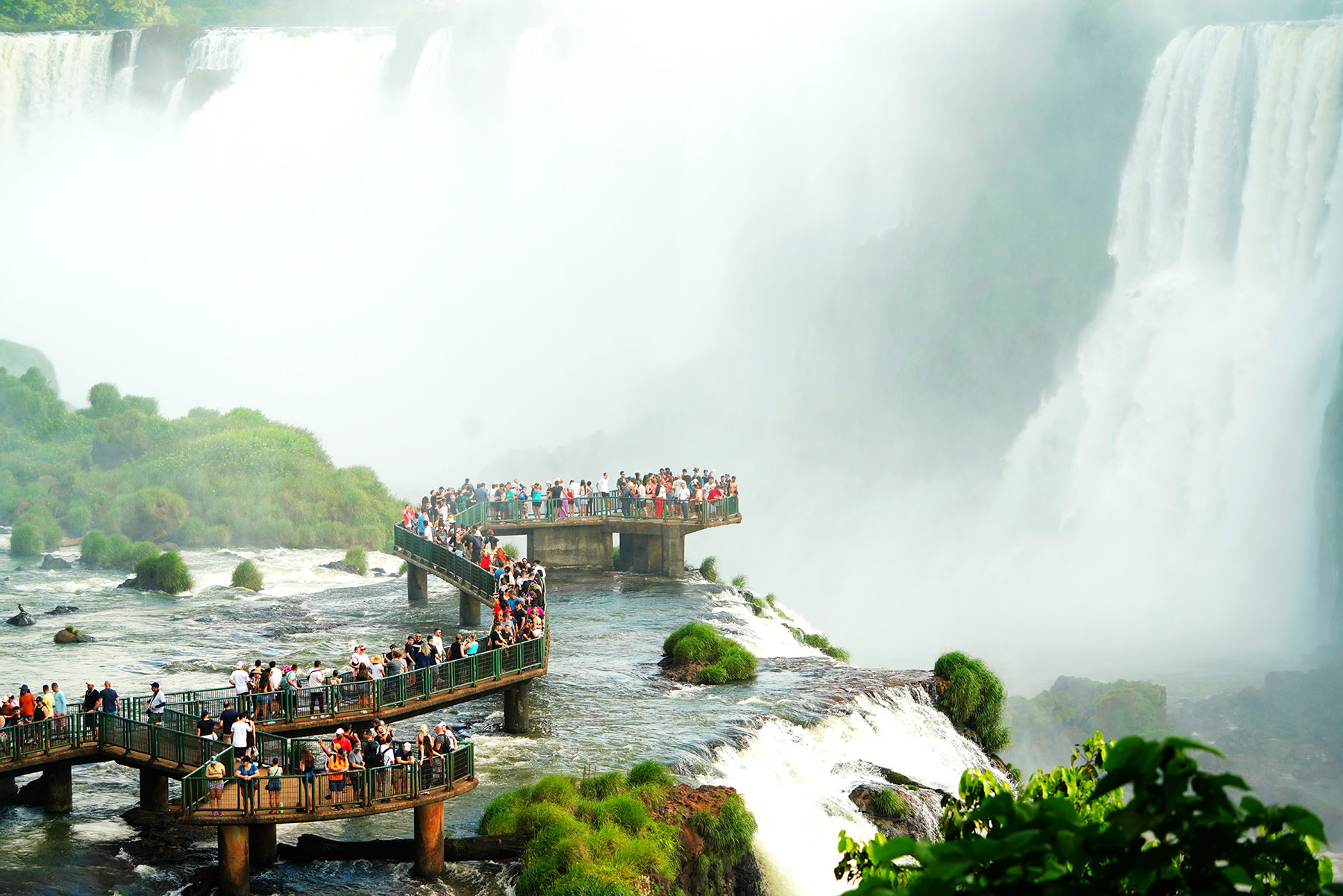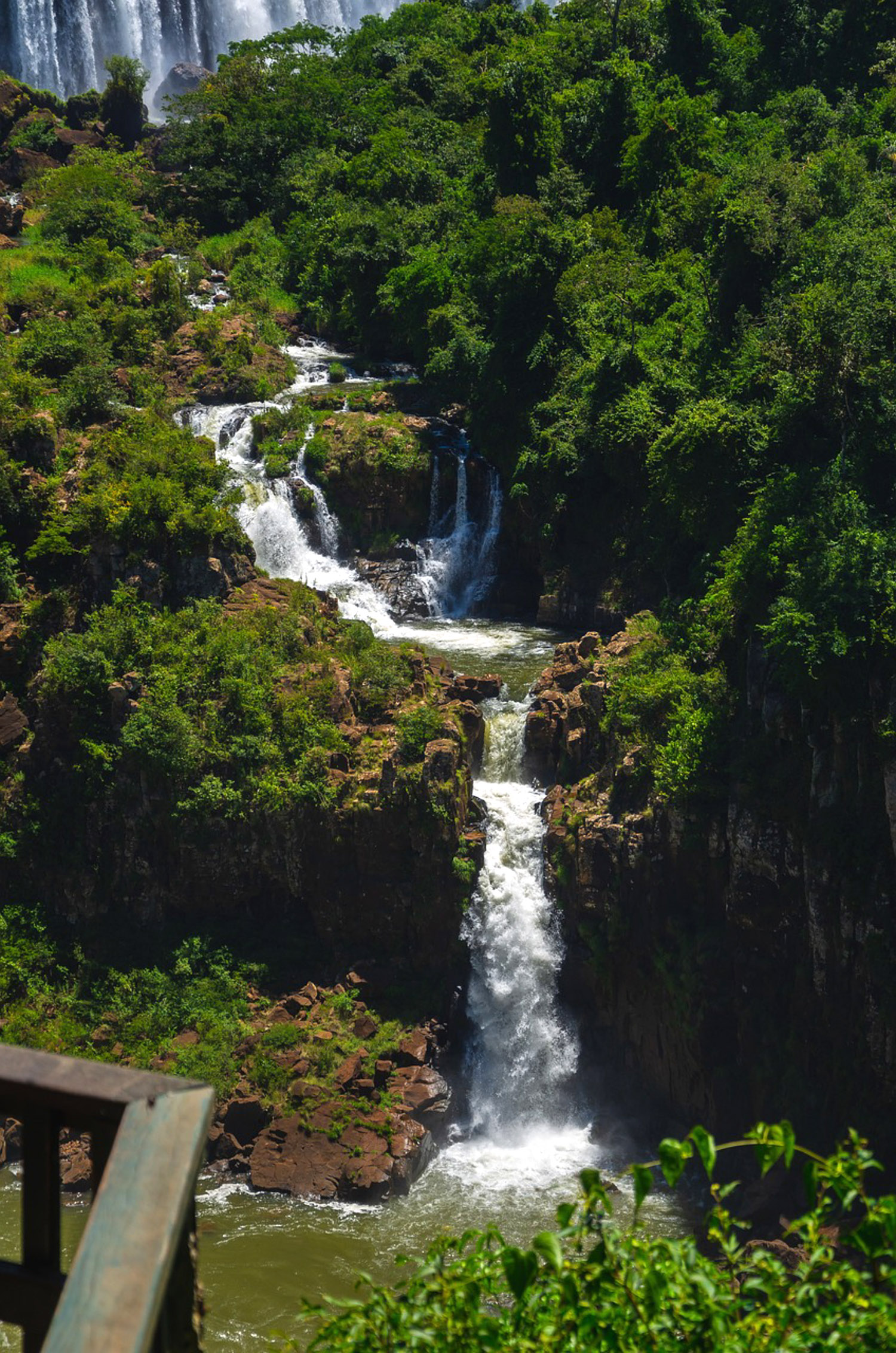Chinese tourists flock to scenic Iguazu Falls on the border of Argentina and Brazil

In the northeast of Argentina, straddling the border with Brazil, sit the longest series of waterfalls in the world. A magnet for about 1.5 million visitors every year, Iguazu Falls is one of the Seven Natural Wonders of the World and one of the most impressive sights in Latin America.
Over the last few years, Chinese tourists have been increasingly willing to travel to the edges of the rainforest to take in the spectacle of the falls and the forest around them.
Most travel to Buenos Aires, the capital of Argentina and the biggest tourist landing spot in the country, and use that as the takeoff point for the two-hour flight north to Puerto Iguazu, the city closest to the falls.
Once at Iguazu Falls, they can take in the 275 individual waterfalls along 2.7 kilometers that make up Iguazu.
From Beijing, Buenos Aires is among the farthest national capitals in the world. The journey can take more than 20 hours, depending on the route.
More than 3 million people are expected to visit Buenos Aires this year to take in the many cultural sights, eat the country's famous parrillas (barbecue) and travel to the many tourist attractions throughout the country.
Many of them choose to head south to the expanses of Patagonia and perhaps take an Antarctic cruise, while others head west to the mountains and ski resorts along the Andes mountains. Another option is to stay closer to Buenos Aires in the center of the country and check out the vast expanses and ranches of the Pampas or head east to the Atlantic Ocean beaches.
READ MORE: Kuala Lumpur alive with vibrant celebrations for Chinese New Year
Over the last few years, many visitors to Argentina have chosen to head north, to the province of Misiones that borders Brazil. The province is home to the Argentine side of Iguazu Falls.
"Chinese visitors are captivated by Argentina, and many express a desire to explore the country further," said Matias Esteras, chief executive of Vivaterra, a travel agency in Argentina that arranges trips and tours.
"They frequently visit not only Iguazu and Buenos Aires but also various areas of Argentine Patagonia, where they are amazed by the landscapes, silence, and moments of peace."
"Iguazu National Park is well-preserved, clean and offers an intense experience of the river, jungle and nature," said Esteras.
Iguazu Falls sit some 1,300 km north of Buenos Aires, with many daily flights that take you to it in a couple of hours. Puerto Iguazu, the city closest to the park, sits in a geographical triangle within Argentina that shares borders with both Paraguay and Brazil.

Charming city
Puerto Iguazu is a charming city marked by a vibrant local culture, surrounded by lush subtropical forests and scenery, and artisan markets. Visitors can explore the markets or experience the local cuisine and hospitality. Its location near the tri-border area gives it a unique vibe.
"The national park is a 30-minute drive from downtown Puerto Iguazu," said Micaela Pereyra, a travel agent. Tours can be easily booked from there as well.
Pereyra recommends staying at least two nights to explore the Argentine side of the Iguazu National Park and the Brazilian side "which, though featuring fewer waterfalls, offers a unique perspective of the falls".
"Visiting the Brazilian side typically requires three or four hours, including crossing the land border between Argentina and Brazil," said Pereyra.
"If you have a free afternoon, consider visiting the Three Borders Landmark, where Argentina, Brazil and Paraguay meet. The site features a daily light and sound show," Pereyra said.
"Longer stays in Puerto Iguazu offer opportunities for horseback riding in the jungle or visiting Guira Oga, an animal rescue center where guided tours showcase the work done with rescued wildlife," Pereyra added.
The falls have become increasingly famous over the last few decades. They are often featured in Hollywood movies and are, since 1984, a UNESCO World Heritage Site.
They are also at the heart of one of South America's most crucial subtropical rainforest ecosystems, with more than 2,000 plant species and wildlife such as tapirs, giant anteaters, howler monkeys, ocelots, jaguars and caimans. There are also hundreds of birds, butterflies, and curious coati mammals in store for visitors on the Brazilian side of the falls.
The best time to visit the falls is from October to March. Visitors who choose to travel as part of groups usually spend two days traveling to Iguazu Falls from Buenos Aires, said Esteras, the Vivaterra CEO.
On the first day, groups often explore the Argentine side of the falls, which has three different circuits. Visitors can take inflatable boat rides to get closer to the falls.
"The lower circuit allows for close-up views of the river and falls from below. The upper circuit offers views of the river before it cascades into the falls, offering an incredible perspective," Esteras said. "The highlight is the Devil's Throat, one of the most impressive."
On the second day, visitors often explore the Brazilian side, which offers a more panoramic — albeit more distant — view of the Iguazu.
"While 80 percent of the falls are on the Argentine side, the most picturesque photo opportunities, with all the falls visible at once, are from the Brazilian side," said Esteras.
Argentina, Brazil and China have taken steps to strengthen tourism relations. Brazil, for instance, recently introduced a 10-year visa policy to encourage travel and business exchanges.
Argentina has become a key destination for Chinese tourists, many of whom are attracted by the country's reputation as a soccer powerhouse or won over by the increased connectivity between the two countries, as well as visa assistance for Chinese tourists.
This trend is visible throughout Latin America, with Brazil, Argentina and Peru the most popular destinations in the region during the first few months of 2024, according to the Chinese travel portal Qunar. The portal recently noted that Chinese tourists are increasingly likely to choose exploratory or immersive natural experiences during visits to Latin America.
Helicopter rides over Iguazu Falls and hikes in the rainforest are among the top choices, but horse rides and boat rides are also common, as are food tours and shopping excursions.
Tourism authorities throughout the region have taken steps to make visits easier and more accessible. In 2017, Brazil and Argentina launched a joint tourism promotion program, including promotional tours in Beijing, Shanghai and Guangzhou, to woo more visitors from China. The Brazilian Tourist Board announced plans to join China's travel trade show in Shanghai this year.
"We have found Chinese visitors to be easy to work with, always pleasant and eager to explore remote places," said Esteras.

Long history
One often overlooked feature of Iguazu is its history, which goes back many millennia.
More than 10,000 years ago, the hunter-gatherers of the Eldoradense culture lived in the area. They were displaced around the year 1000 by the Guarani, who brought new agricultural technologies. The Guarani themselves were displaced by the Spanish and Portuguese conquistadors in the 16th century.
The Spanish explorer Alvar Nunez Cabeza de Vaca named the falls Saltos de Santa Maria in 1541. Later, Jesuit missions followed. A Brazilian army officer, Edmundo de Barros, suggested the creation of a national park near the falls in 1897.
The horseshoe-shaped falls create a natural border between Brazil and Argentina. Once the boundaries of the countries were defined, two separate national parks were established, Iguazu National Park in Argentina and Iguacu National Park in Brazil's Parana state.
ALSO READ: Hit travel reality show ventures abroad to Laos
The falls are also important as a source of power, with the huge Itaipu Hydroelectric Plant jointly built by Paraguay and Brazil and completed in 1991. The dam is one of the largest in the world, providing nearly 15 percent of Brazil's electricity and 90 percent of Paraguay's.
In 2011, the Iguazu National Park and Iguazu Falls were chosen as one of the "Seven Natural Wonders of the World".
The Iguazu Park, which covers more than 67,620 hectares, has a team of protectors who guard the local environment and biodiversity.
Starting in 1996, Iguazu Argentina supervises the infrastructure that makes visiting the falls possible. The entity oversees and maintains water sewers, walkways, walks and trails, an ecological train, and an underground electrical system to help preserve plant and animal species in the park.
The writer is a freelance journalist for China Daily.


